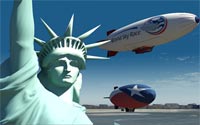UNESCO and World Air League join forces to safeguard world heritage

- © World Sky Race
UNESCO’s World Heritage Centre and the World Air League, a U.S.-based nongovernmental organization, will present an ambitious partnership on 24 September, to promote and safeguard world heritage. The partnership is born of the realization that skyships can contribute to sustainable tourism, and reduce pollution and environmental stress that is affecting both natural and cultural sites.
The key event in the partnership is the World Sky Race, scheduled to take place in 2010. In 16 back to back races, Zeppelins and skyships will cover 48,000 km (30,000 miles) around the world with stops at iconic sites including many on UNESCO’s World Heritage list, such as Greenwich (UK); the Coliseum in Rome (Italy), the Pyramids of Giza (Egypt), the Taj Mahal (India); the Pre-Hispanic City of Teotihuacan (Mexico).
Other notable stops will include Mount Fuji in Japan and, in the U.S.A., Kilauea Volcano and Diamond Head (Hawaii); Golden Gate Bridge (San Francisco); the NASA Johnson Space Center (Houston); and the Statue of Liberty (New York City).
This event is expected to generate massive publicity for World Heritage and help raise awareness of, as well as funding for, preservation.

Designed to stimulate research and development into lighter than air-craft-transportation, the race will showcase the huge potential of such transportation, which can decrease fuel consumption by 89% compared to long haul jet aircraft. This represents a significant reduction in the carbon footprint.
Compared to road transportation, skyships can reduce energy consumption and associated emissions by 75%. Their use can also reduce the impact on roadway infrastructure and enable service to pristine areas without the need to build and intrusive infrastructure (roads and large infrastructure).
The race will also showcase the advantages of lighter-than-air aircraft in terms of infrastructure as they can land on grounds no larger than a football pitch, which represent a much smaller use of resources and impact on the environment than the airfields used by aeroplanes.
By travelling over a large number of UNESCO World Heritage sites, the Sky Race will help promote heritage, and demonstrate the skyships’ potential contribution to sustainable tourism in general and to reducing the stress that tourism represents for World Heritage properties in particular.
UNESCO and the World Air League are looking at using the World Sky race to develop educational activities and raise awareness of World Heritage and of environmental issues. More partners, including key players in the aviation industry, are expected to join in the partnership whose presentation at UNESCO will be attended by the Permanent Delegates of many of the countries which will be visited by the race.
The presentation will take place at UNESCO Headquarters at 6 p.m.
- Author(s):Media Advisory N°2008-61
- Source:UNESCOPRESS
- 23-09-2008
- © World Sky Race -

